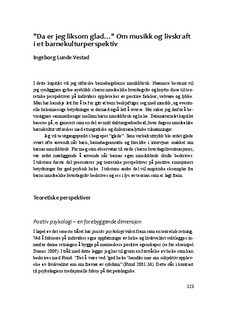Da er jeg liksom glad… Om musikk og livskraft i et barnekulturperspektiv
Chapter, Peer reviewed
Permanent lenke
http://hdl.handle.net/11250/172355Utgivelsesdato
2012Metadata
Vis full innførselSamlinger
- Artikler og bokkapitler [390]
Originalversjon
I: Barn, musikk, helse, s. 123-146Sammendrag
In this text an ethnographical approach to how children use music in their everyday lives is linked with theoretical perspectives from positive psychology. By combining empirical examples on how music is used as a part of Norwegian children’s culture and theoretical perspectives on well-being and happiness, I suggest that music can be understood as a technology of health, that is, as a tool that can support children’s flourishing. Music seems to be able to elicit positive feelings in the moment. However, according to the theortical perspectives, this can also be linked to well-being and health in a long-term perspective.The participants of the study described music as a tool with which children carry ”good things” and good feelings. Further,”joy” was a word frequently used in the participants’ descriptions of music, as well as descriptions of situations where music was used. The word ”joy”, however, seemed to refer to and to be linked with a number of positive feelings, described in the theory of well-being and happiness as contentment, engagement, harmony, balance, and serenity. Such nuances are explored in this chapter. I concentrate first on joy, then on music as a fuel for human relations, children’s needs for harmony and balance, and regulation of emotions.
Utgiver
Norges musikkhøgskoleSerie
Skriftserie fra Senter for musikk og helse;5NMH-publikasjoner;2012:3
